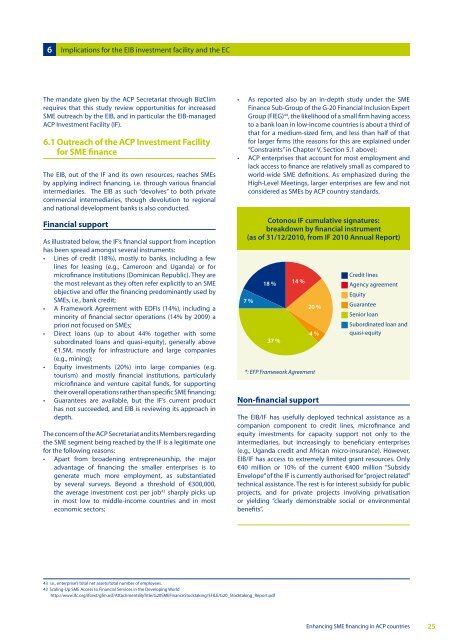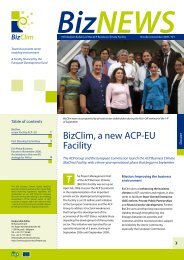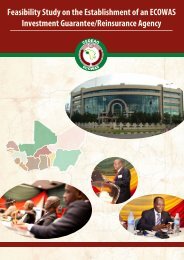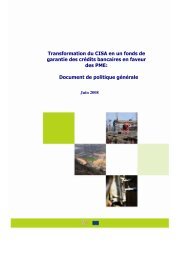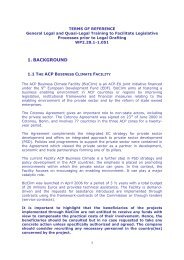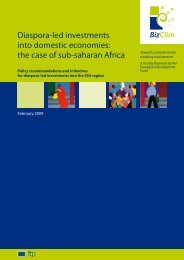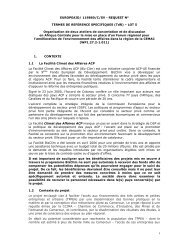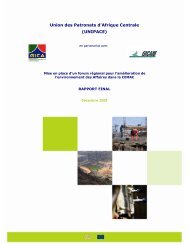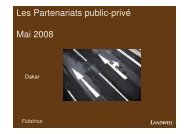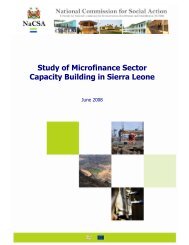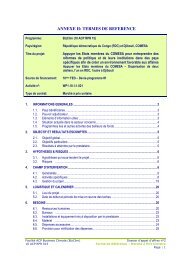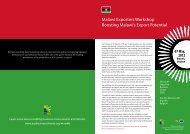Enhancing smE financing in acp countries - ACP Business Climate
Enhancing smE financing in acp countries - ACP Business Climate
Enhancing smE financing in acp countries - ACP Business Climate
Create successful ePaper yourself
Turn your PDF publications into a flip-book with our unique Google optimized e-Paper software.
6<br />
Implications for the eib <strong>in</strong>vestment facility and the ec<br />
The mandate given by the <strong>ACP</strong> Secretariat through BizClim<br />
requires that this study review opportunities for <strong>in</strong>creased<br />
SME outreach by the EIB, and <strong>in</strong> particular the EIB-managed<br />
<strong>ACP</strong> Investment Facility (IF).<br />
6.1 Outreach of the <strong>ACP</strong> Investment Facility<br />
for SME f<strong>in</strong>ance<br />
The EIB, out of the IF and its own resources, reaches SMEs<br />
by apply<strong>in</strong>g <strong>in</strong>direct <strong>f<strong>in</strong>anc<strong>in</strong>g</strong>, i.e. through various f<strong>in</strong>ancial<br />
<strong>in</strong>termediaries. The EIB as such “devolves” to both private<br />
commercial <strong>in</strong>termediaries, though devolution to regional<br />
and national development banks is also conducted.<br />
F<strong>in</strong>ancial support<br />
As illustrated below, the IF’s f<strong>in</strong>ancial support from <strong>in</strong>ception<br />
has been spread amongst several <strong>in</strong>struments:<br />
• L<strong>in</strong>es of credit (18%), mostly to banks, <strong>in</strong>clud<strong>in</strong>g a few<br />
l<strong>in</strong>es for leas<strong>in</strong>g (e.g., Cameroon and Uganda) or for<br />
microf<strong>in</strong>ance <strong>in</strong>stitutions (Dom<strong>in</strong>ican Republic). They are<br />
the most relevant as they often refer explicitly to an SME<br />
objective and offer the <strong>f<strong>in</strong>anc<strong>in</strong>g</strong> predom<strong>in</strong>antly used by<br />
SMEs, i.e., bank credit;<br />
• A Framework Agreement with EDFIs (14%), <strong>in</strong>clud<strong>in</strong>g a<br />
m<strong>in</strong>ority of f<strong>in</strong>ancial sector operations (14% by 2009) a<br />
priori not focused on SMEs;<br />
• Direct loans (up to about 44% together with some<br />
subord<strong>in</strong>ated loans and quasi-equity), generally above<br />
€1.5M, mostly for <strong>in</strong>frastructure and large companies<br />
(e.g., m<strong>in</strong><strong>in</strong>g);<br />
• Equity <strong>in</strong>vestments (20%) <strong>in</strong>to large companies (e.g.<br />
tourism) and mostly f<strong>in</strong>ancial <strong>in</strong>stitutions, particularly<br />
microf<strong>in</strong>ance and venture capital funds, for support<strong>in</strong>g<br />
their overall operations rather than specific SME <strong>f<strong>in</strong>anc<strong>in</strong>g</strong>;<br />
• Guarantees are available, but the IF’s current product<br />
has not succeeded, and EIB is review<strong>in</strong>g its approach <strong>in</strong><br />
depth.<br />
The concern of the <strong>ACP</strong> Secretariat and its Members regard<strong>in</strong>g<br />
the SME segment be<strong>in</strong>g reached by the IF is a legitimate one<br />
for the follow<strong>in</strong>g reasons:<br />
• Apart from broaden<strong>in</strong>g entrepreneurship, the major<br />
advantage of <strong>f<strong>in</strong>anc<strong>in</strong>g</strong> the smaller enterprises is to<br />
generate much more employment, as substantiated<br />
by several surveys. Beyond a threshold of €300,000,<br />
the average <strong>in</strong>vestment cost per job 43 sharply picks up<br />
<strong>in</strong> most low to middle-<strong>in</strong>come <strong>countries</strong> and <strong>in</strong> most<br />
economic sectors;<br />
• As reported also by an <strong>in</strong>-depth study under the SME<br />
F<strong>in</strong>ance Sub-Group of the G-20 F<strong>in</strong>ancial Inclusion Expert<br />
Group (FIEG) 44 , the likelihood of a small firm hav<strong>in</strong>g access<br />
to a bank loan <strong>in</strong> low-<strong>in</strong>come <strong>countries</strong> is about a third of<br />
that for a medium-sized firm, and less than half of that<br />
for larger firms (the reasons for this are expla<strong>in</strong>ed under<br />
“Constra<strong>in</strong>ts” <strong>in</strong> Chapter V, Section 5.1 above);<br />
• <strong>ACP</strong> enterprises that account for most employment and<br />
lack access to f<strong>in</strong>ance are relatively small as compared to<br />
world-wide SME def<strong>in</strong>itions. As emphasized dur<strong>in</strong>g the<br />
High-Level Meet<strong>in</strong>gs, larger enterprises are few and not<br />
considered as SMEs by <strong>ACP</strong> country standards.<br />
Cotonou IF cumulative signatures:<br />
breakdown by f<strong>in</strong>ancial <strong>in</strong>strument<br />
(as of 31/12/2010, from IF 2010 Annual Report)<br />
7 %<br />
18 % 14 %<br />
37 %<br />
20 %<br />
4 %<br />
*: EFP Framework Agreement<br />
Non-f<strong>in</strong>ancial support<br />
Credit l<strong>in</strong>es<br />
Agency agreement<br />
Equity<br />
Guarantee<br />
Senior loan<br />
Subord<strong>in</strong>ated loan and<br />
quasi-equity<br />
The EIB/IF has usefully deployed technical assistance as a<br />
companion component to credit l<strong>in</strong>es, microf<strong>in</strong>ance and<br />
equity <strong>in</strong>vestments for capacity support not only to the<br />
<strong>in</strong>termediaries, but <strong>in</strong>creas<strong>in</strong>gly to beneficiary enterprises<br />
(e.g., Uganda credit and African micro-<strong>in</strong>surance). However,<br />
EIB/IF has access to extremely limited grant resources. Only<br />
€40 million or 10% of the current €400 million “Subsidy<br />
Envelope” of the IF is currently authorised for “project related”<br />
technical assistance. The rest is for <strong>in</strong>terest subsidy for public<br />
projects, and for private projects <strong>in</strong>volv<strong>in</strong>g privatisation<br />
or yield<strong>in</strong>g “clearly demonstrable social or environmental<br />
benefits”.<br />
43 i.e., enterprise’s total net assets/total number of employees.<br />
43 Scal<strong>in</strong>g-Up SME Access to F<strong>in</strong>ancial Services <strong>in</strong> the Develop<strong>in</strong>g World<br />
http://www.ifc.org/ifcext/gfm.nsf/AttachmentsByTitle/G20SMEF<strong>in</strong>anceStocktak<strong>in</strong>g/$FILE/G20_Stocktak<strong>in</strong>g_Report.pdf<br />
<strong>Enhanc<strong>in</strong>g</strong> SME <strong>f<strong>in</strong>anc<strong>in</strong>g</strong> <strong>in</strong> <strong>ACP</strong> <strong>countries</strong><br />
25


